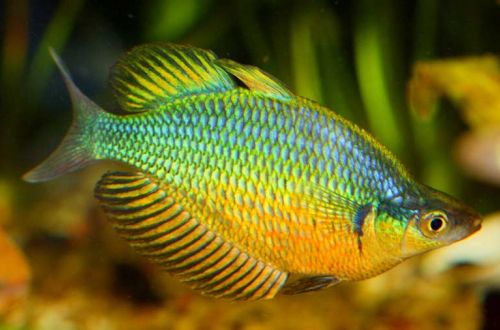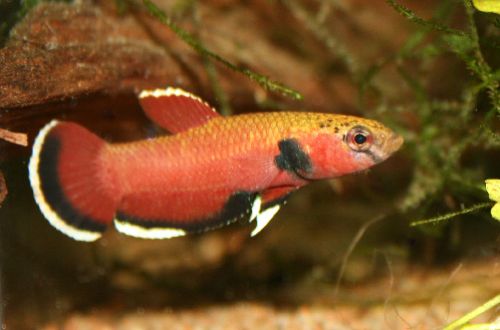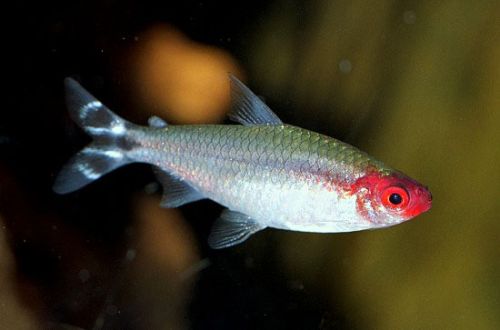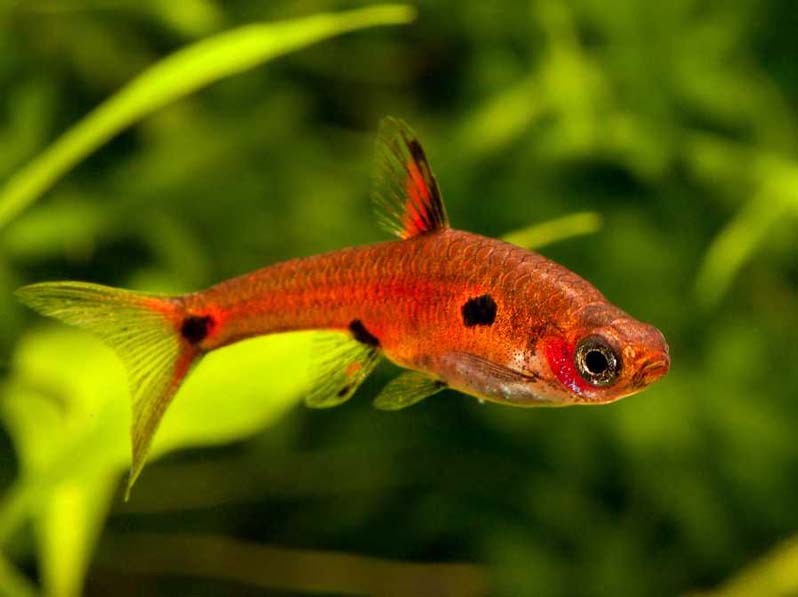
dwarf rasbora
The pygmy rasbora, scientific name Boraras maculatus, belongs to the Cyprinidae family. One of the smallest species among cyprinids, but its miniature size does not make it less noticeable – a flock of a dozen of these fish looks quite impressive. Rasbora requires certain conditions of keeping and careful selection of neighbors, which is why it cannot be recommended to beginner aquarists.

Contents
Habitat
Dwarf rasbora was first described in 1904, during a study of the fauna of Southeast Asia. In nature, these fish live in shaded ponds with a slow current – in forest streams and rivers, peat bogs, as well as ponds and canals. Fish take refuge among fallen leaves and branches, where the water is soft and acidic. Rasbor flocks feed on small insects, worms and zooplankton.
Requirements and conditions:
- The volume of the aquarium – from 20 liters.
- Temperature – 23-26°C
- Value pH — 5.0–6.0
- Water hardness – soft (5-12 GH)
- Substrate type – any dark
- Lighting – subdued
- Brackish water – no
- Water movement – weak or still water
- Size – up to 3 cm.
- Feeding – any food of suitable size
- Life expectancy – from 3 to 5 years
Description
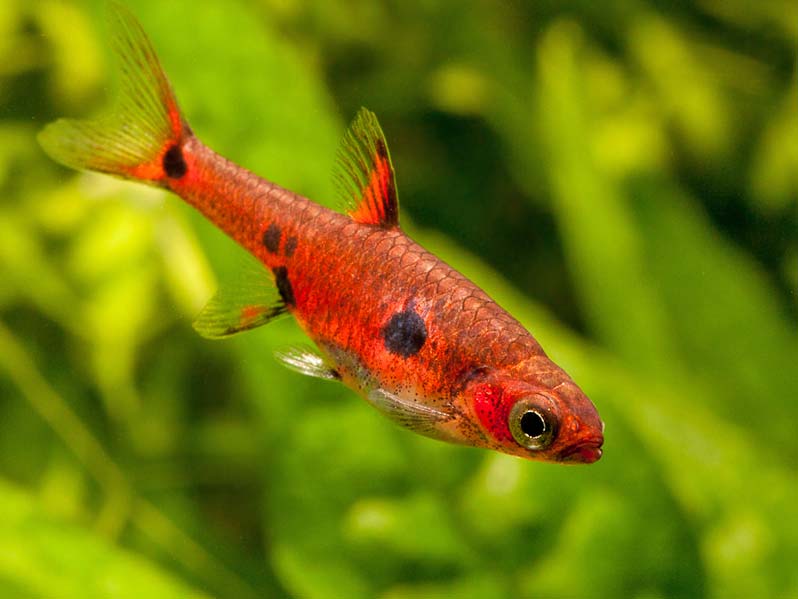
A slender small fish no larger than 3 cm in size, it is distinguished by a bright color with a predominance of a red hue and several rounded dark spots on the sides, which are located near the pectoral and anal fins, near the tail. Differences in the saturation of shades depend on the place of origin of the fish and on the sex – the male is brighter. Coloration can vary from cherry red to orange, depending on diet and lighting.
Food
Dwarf rasbora belongs to omnivorous species, in the conditions of an aquarium it is able to feed exclusively on dry industrial food intended for this species. It is advisable to use foods with color enhancing additives to make your pets look brighter. Small crustaceans, such as daphnia or brine shrimp, can diversify the diet.
Maintenance and care
Fish need high quality water, a prerequisite is the renewal of half of all water at least once a month and regular cleaning of the soil with a siphon. The use of a filter with a peat element will provide the necessary pH level. Abrupt changes in hydrochemical parameters should be avoided, therefore, before updating the water, all values should be brought to a common denominator. The water added must exactly match the water in the aquarium in terms of pH, hardness and temperature.
The size of the fish allows you to keep them in small tanks from 20 liters (these are only two buckets of water), deciduous plants B, compactly located next to the shelters, should be used as decoration. Lighting is subdued, and floating plants provide additional shaded areas. The dark substrate is the natural color of the soil found in the habitats of Rasbor, which also favorably emphasizes the color of the fish.
Social behavior
Be sure to keep a flock of at least 8-10 individuals, with a smaller number they begin to behave restlessly, and as a result, constant stress in all the ensuing consequences. As neighbors, fish of similar size should be selected, not too active and in small numbers. Such a task looks difficult, especially when you consider that the selected neighbors must also be adapted to life in soft and slightly acidic water, so optimal conditions are achieved only in a species aquarium inhabited exclusively by Dwarf rasboras.
Sexual differences
Females have more rounded bellies and tend to be larger than males. Males, in turn, have a more intense color during spawning.
Breeding / breeding
Breeding Dwarf parsing requires a certain skill. Like other cyprinids, they lay eggs directly on the substrate and do not care about its safety, in addition, fish can eat it, so it is better to spawn in a separate tank.
The spawning tank should be small, filled with water only 15 cm or a little more. It is advisable to use water from the main aquarium, a heater (set the temperature around 26–27 ° C) and an aerator are sufficient from the equipment, a filter is not necessary. Soil from small balls up to 1 cm in diameter or similar gravel, eggs will fall into the spaces between the pebbles, this will prevent their parents from eating them. From plants, preference should be given to low, preferably creeping on the ground, with small leaves.
Place 2 or 3 pairs in a spawning tank, spawning will begin in about two weeks, at which time the males determine the territory. Spawning usually occurs in the morning after a long courtship procedure, after which the female lays eggs.
The fry emerge in about 24 to 36 hours and are extremely small. They should be fed with microfood – specially purchased at a pet store or prepared on their own from crushed flake food, which is fed to adult fish.
Diseases
The fish are prone to many common diseases even when kept in good conditions, and are also sensitive to drugs, which makes it impossible to carry out the treatment procedure in a community aquarium. Sick fish should be transplanted into a quarantine aquarium, the recommended dose of the drug should be halved. Read more about symptoms and treatments in the Fish Diseases section.
Features
- small fish sizes
- Mandatory pack keeping
- Hypersensitivity to drugs
- Can jump out of the aquarium



